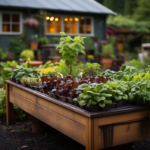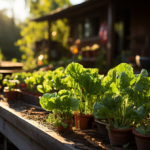Table of Contents
Winning the Battle Against Garden Pests: Proven Techniques for a Healthy Vegetable Harvest
Hey there, green thumbs! We’ve all been there – you step out into your vegetable garden, eager to see how your crops are growing, only to find that some uninvited dinner guests have beaten you to it. Yeah, I’m talking about those pesky pests that munch away on your tomatoes and salad leaves, making a feast of your veggie patch. It’s enough to make any gardener want to throw in the trowel.
But don’t fret! Dealing with bugs and pests doesn’t have to feel like a losing battle. In fact, I’ve got a bunch of really effective strategies to share with you that would help fend off those annoying critters. From common beetles to not so lovely slugs and aphids – we’re covering them all. And best of all, these techniques are all natural and eco-friendly.
So, forget about nasty pesticides. It’s time to outwit these critters the old-school way and reclaim the fruits (or veggies actually) of your labor. Stick around, read up, and join me on the route to a healthier, pest-free garden. Let’s dive in, shall we?
Identifying Common Vegetable Garden Pests: Know Your Enemy
Let’s start with the basics, shall we? Knowing your enemy is half the battle, right? Here, we’ll identify the most common pests attacking your beloved vegetable garden.
Pests come in all shapes and sizes. Some are relatively harmless while others can cause total havoc. Identifying them correctly is the first step to effective control. Here’s the most wanted list you might find lurking in your greens:
- Aphids: These tiny, pear-shaped critters are often green or black. A sure sign that they’ve visited your garden are curled leaves and the sticky substance they leave behind, known as “honeydew”.
- Slugs and Snails: Probably one of the most easily recognizable pests. These slimy creatures love munching on your lettuce, radishes, tomatoes, and more. They usually attack during the night or on damp, overcast days.
- Caterpillars: They might seem cute, but these little wrigglers have big appetites! Look for holes in your leaves or partially eaten fruits, and you might find a caterpillar culprit.
- Beetles: These guys come in a variety of shapes, sizes, and colors. The damage they inflict varies as well–from holes in the leaves, slices on fruits to eating the plant from its roots.
- Whiteflies: These minuscule flying insects are often found on the undersides of leaves. An infestation often results in wilting or yellowing leaves due to their feasting on plant sap.
It’s also important to remember that not all bugs are bad. Certain insects and bugs are nature’s way of controlling the destructive ones. So before you start going all Rambo on any bug you see, make sure you’re not doing more harm than good.
Understanding these common pests’ behaviors and traits can significantly help when planning and implementing strategies to protect your luscious veggies. Stay tuned for the next section where we’ll dig into organic pest control practices that are easy and safe to implement. Let’s turn those pests into pasts, the eco-friendly way!
Organic Pest Control: Safe and Sustainable Practices
Okay my fellow green thumbs, let’s roll up our sleeves and dig into how we can wage war on these pests the organic, Earth-friendly way. No harmful chemicals, no side effects for your other plants or friendly bugs.
First up, let’s talk about natural enemies. Yes, you heard that right. Not all bugs are bad and some can actually help by preying on our not-so-friendly pests. Birds, spiders, frogs, ladybugs, and even other insects like lacewings and certain types of wasps can be your best mates in your war against pests. Encourage these natural predators to visit and live in your garden and let nature take care of itself.
- Companion planting is another favorite tactic. For example, planting garlic near roses can deter aphids, and nasturtiums can sidetrack pests away from your beans. The science behind this is that some plants can either confuse pests or repel them altogether with their strong scents.
- Diatomaceous earth is a super effective, natural powder made from tiny fossilized aquatic organisms. It destroys pests like beetles, slugs, and other soft-bodied pests, without any harm to your crops or friendly insects. Just sprinkle it around your plants, and voila!
- Go homemade. Mix some water with natural soap for a cheap, environment-friendly bug spray. Alternatively, concoctions using hot pepper, garlic, or vinegar can send pests running for the hills (or more accurately, the next garden!).
- Lastly, if it’s possible, physically remove pests from your plants. Plucking off beetles, handpicking snails, or gently washing aphids off leaves with water is tedious, but trust me, it works!
From encouraging natural enemies, to organic home remedies, these safe and sustainable practices can make a huge difference to the health and productivity of your vegetable garden. And the best part is, they won’t hurt Mother Nature.
In the upcoming section, we’ll dig into companion planting in more detail. Ready to discover how to turn your veggies into a pest confusing jungle? Let’s move on!
Companion Planting: Nature’s Way of Pest Control
Now that we’ve learnt about some organic methods, let’s tap into something even cooler. Step aside Batman and Robin, there’s a new dynamic duo in town. Cue, Companion Planting. This method won’t just help fend off pests, it also promotes a healthier ecosystem in your garden.
Companion planting is all about creating plant partnerships in your garden. These pairs can help each other in many ways, from boosting each other’s growth, improving flavor, to importantly, controlling pests! Let’s breakdown a few of these superhero duos:
- Marigolds and veggies – planting marigolds among your vegetables works amazing. These pretty flowers aren’t just for show; their unique scent confuses pests, sending them off track.
- Here’s another unexpected pair – Tomatoes and Cabbage. Planting tomatoes near your cabbage can deter diamondback moth larvae, which are notorious for chewing unsightly holes in cabbage leaves.
- Basil and Thyme are terrific when planted around your tomato plants. They repel a variety of pests, including those pesky aphids and tomato hornworms. Plus, you’ve got yourself the beginnings of a nice pasta sauce growing together!
- Don’t forget to mix in some garlic among your rose bushes! Not only does this keep aphids away, but your roses might end up with a more potent fragrance.
- Last but not least, nasturtiums are a great option to protect your cucumbers from aphids and cucumber beetles. Plus, they add a splash of color to your vegetable garden!
Remember, it’s not just about deterring pests. Companion plants also promote beneficial insects, which are natural predators of those pesky intruders. This is truly nature’s pest management at its best!
Next on our agenda, let’s talk about building defenses! We’ll look at how physical barriers and traps can help guard your treasured veggies from those pesky invaders. Onwards, garden warriors!
Physical Barriers and Traps: Keeping the Bugs at Bay
Alright green thumbs, let’s brace ourselves and build up those defenses! By setting up physical barriers and traps, we are literally creating walls between our beloved veggies and those uninvited pests. So let’s chat on how we can make our garden into a pest-proof fortress.
- Floating row covers are a great start. These lightweight blankets made out of spun polyester or polypropylene let light and water in while blocking many pests. Simply place them over your veggies, and secure the edges with rocks, soil or stakes. Easy right?
- Ever considered a garden net or mesh? These work wonders against birds, rabbits, or bigger pests who are after your produce. Just ensure the mesh holes are appropriate for your specific pests.
- Collars made out of aluminum foil or cardboard can stop cutworms dead in their tracks. Snugly wrap them around the stems of your seedlings and you’ll save them from those nasty nibbles.
- Next up, slug and snail fences. These deterrents use a small electric charge to gently discourage our slimy friends from making a meal out of your plants.
- Homemade or store-bought traps come in handy too. For example, a simple dish of beer can attract slugs and drown them, or yellow sticky traps can catch a multitude of flying pests.
- Don’t forget our winged friends – the birds. Install bird feeders/baths or nest boxes to invite them over. They’ll happily munch on many pests, including some we might not even see!
By incorporating these physical barriers and traps, we can majorly level up our pest-defense game. Combined with our earlier strategies, we are turning our gardens into real fortresses!
However, the battle isn’t over just yet. The next part of our discussion will introduce some unlikely allies in our garden – beneficial bugs and insects. Stay tuned, troops!
Beneficial Bugs and Insects: Unlikely Allies in Your Garden
Okay green thumbs, let’s take a minute to appreciate the unsung heroes of our gardens. Yup, you guessed it – the beneficial bugs and insects. These tiny warriors can be our saving grace when dealing with pesky pests. They’ll eat them, outcompete them, and sometimes even lay their eggs in them (gross, but effective!).
Here are some top creatures that you’re going to want to roll out the welcome mat for:
- Ladybugs: Did you know a single ladybug can eat up to 5,000 aphids in its lifetime? So if you spot these little red beetles, celebrate! They’re your aphid archenemy.
- Lacewings: With a taste for aphids, mealybugs, caterpillars, and other pests, these guys are another great ally. You’ll recognize them by their transparent, lacy wings.
- Hoverflies: While their larvae love munching on aphids and thrips, adult hoverflies help pollinate your garden. Double win!
- Parasitic Wasps: Don’t be scared off by their name, these critters are seriously handy. They lay their eggs in or on other pests. When the eggs hatch, they start munching (I know, grim stuff).
- Spiders: Sure, they might give some of us the heebie-jeebies, but spiders are incredible pest hunters. From inside a bell pepper to among your beans, they set up camp and do some serious pest patrol.
Attracting these beneficial bugs can be as simple as planting the right flowers and herbs in your garden. Yarrow, dill, fennel, marigold, and sunflowers are just a few examples to get you started. Plus, they’ll make your garden unbelievably beautiful.
As we reach the final leg of our pest control journey, we’re going to look at pest-resistant plant varieties and regular garden maintenance. So, keep up the momentum and join me in the home stretch!
Homemade Insect Spray Recipes: Natural and Non-toxic Solutions
Alrighty garden warriors, who’s up for a bit of a DIY project? Sometimes, our best weapon against those critters is something whipped up right in our kitchen. So let’s talk homemade insect sprays. They’re easy to make, safe for your veggies, and, best of all, kind to Mother Nature.
Let’s break down a few recipes:
- Garlic Insect Spray: Blend two whole bulbs of garlic with a small amount of water, then strain it and add enough water to make a gallon. After that, add a quarter cup of dish soap. Spray it on your plants every few days until the bug problem is resolved.
- Pepper Spray: Blend two cups of hot peppers (the hotter, the better!) with a half-gallon of water. Once blended and strained, add in dish soap and you’ve got yourself a powerful (and spicy) bug deterrent.
- Vinegar Spray: Mix three parts water to one part vinegar and voila… an awesome remedy for those pesky bugs. It’s especially good against ants!
- Epsom Salt Spray: Epsom salts work brilliantly against beetles and other leaf eating pests. Dissolve one cup of the salt in a five-gallon bucket of water and blend till well mixed. Then, you’ve got your spray!
- Versatile Vegetable Oil Spray: Mix one cup of vegetable oil with one tablespoon of dish soap. Shake well and mix with a quart of water to apply it. It’s a fantastic general deterrent for a variety of garden pests.
Remember, the key to success with these sprays is continual application until your pest problem dwindles, luckily they are super easy to whip up!
Next up, our final exploration takes us into pest-resistant plant varieties and routine garden maintenance. Let’s dive in and finish our pest fighting journey strong, green thumbs!
Pest-Resistant Plant Varieties: A Proactive Approach to Pest Control
Now, here’s an idea: why not fight pests before they even start? That’s right, by choosing pest-resistant plant varieties, we’re giving ourselves a heads-up in the pest control game.
This isn’t about creating a garden that looks like Fort Knox. It’s about working wisely with nature and choosing plants that are naturally tougher against pests. Here are a few varieties that pests tend to avoid:
- Herbs: Certain ones, like rosemary, sage, and thyme, are famously uninteresting to pests. The strong scents disrupt bugs’ sense of taste and smell, disorienting them.
- Onions and Garlic: As well as being super useful in your kitchen, these plants emit a strong odor that repels pests.
- Japanese Beetles Hate Geraniums: It’s a mouthful, but true. These pests are attracted to the geraniums, consume the leaves, and become disoriented, giving predators a chance to swoop in.
- Tomato ‘Roma VF’: A variety that’s resistant to verticillium and fusarium wilts, two very common soil-borne diseases that affect tomatoes.
By choosing such pest-resistant varieties, we’re already a step ahead in protecting our gardens.
Last but not least, let’s wrap up with Regular Garden Maintenance: An Ounce of Prevention is Worth a Pound of Cure. Stay tuned, fellow green thumbs, for the final piece of our pest-control puzzle!
Regular Garden Maintenance: An Ounce of Prevention is Worth a Pound of Cure
We’re at the tail end of our journey, garden warriors. Now, let’s talk about what might be the most crucial aspect of pest control – regular garden maintenance. Just like any other task, gardening also gets easier with regular upkeep and vigilance.
Although it sounds mundane, multiple smaller actions such as keeping your garden tidy, rotating your crops, checking your plants regularly, and acting quickly at the first sign of trouble can prevent a small problem from becoming a garden-wide infestation.
- Tidying Up: Regularly clear away fallen leaves or rotting fruits which can be a breeding ground for pests. A clean garden is a less attractive place for pests to live.
- Crop Rotation: This stops pests and diseases from becoming established in your soil. Got aphids on your beans last year? Plant something else in that spot this year.
- Regular Check Ups: Make a habit of checking your plants regularly for signs of trouble – not just the leaves, but the stems and the undersides of leaves too. Early detection can be a game-changer!
- Quick Action: If you spot trouble, don’t hesitate to act quickly. Pluck off that caterpillar, spray that bug, or remove that diseased leaf.
Remember, each of these practices is a brick in the fortress that keeps your veggies safe from pests.
Well, that’s a wrap, my fellow garden warriors! We’ve covered everything from identifying pests, implementing eco-friendly control measures, attracting beneficial bugs, to maintaining a healthy, pest-resistant garden. Arm yourself with these effective strategies and say goodbye to those pesky garden critters.
Till the next time, keep those green thumbs up and happy gardening, folks!
Conclusion
And there you have it, my green-thumbed companions! A comprehensive roadmap to a pest-free vegetable garden. Don’t let those pesky critters keep you away from basking in the joy of plucking a perfectly ripe tomato, or crunching into a fresh snap pea straight from the vine.
Remember, every garden — no matter how big or small — has its unique set of challenges when it comes to pests. But with a dash of knowledge, a splash of persistence and a sprinkle of Mother Nature’s wisdom, we can transform our gardens into a fortress against these unwelcome guests. We’ve covered a lot of ground today, from knowing your enemy, attracting natural predators, whipping up homemade insect sprays, opting for pest-resistant plants to most importantly, staying vigilant with regular maintenance.
Keep in mind, winning the war against garden pests isn’t about obliterating every last bug, but striking a balanced ecosystem where each creature plays its part keeping the rest in check. After all, a garden is its own little piece of nature, and every creature, big or small, plays an important role.
As we close this chapter, I want to thank you for embarking on this journey with me. It’s a continuous learning process, but together we’ve taken a giant leap forward. We’re now equipped with effective strategies to keep those annoying pests under control while maintaining a healthy, thriving vegetable garden.
So, go out there, dig in the dirt, and let’s grow some bountiful, bug-free veggies!









